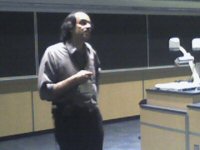Main Menu
Welcome
 The first plenary lecture of the penultimate day at ICN was by Jan Ramirez. The title apparently was a play on words as his talk was about the inhaling component of respiration, inspiration. He started off with some basic neurobiology on central pattern generators (CPGs) in the mammalian brainstem. The talk very quickly advanced into more and more detailed descriptions of the neurobiological mechanisms of inspiration, how the connectivity of the neurons and the different kinds of their interactions in order to accomplish a healthy rhythm. A common principle in many rhythm generating networks is the cooperation of afferent input and central pattern generators. One interesting tidbit was a peculiar property of some pacemaking neurons. Some of these neurons show state-dependent bursting. In the quiescent state a certain input only generates an excitatory potential and maybe one action potential. After the CPG has been active, the same stimulus to the same neuron may elicit a plateau potential and bursting. So the biophysical properties of pacemaker neurons are highly dynamic. Of course, this is not really a surprise, we found this after learning in a decision-making neuron the snail Aplysia (and of course other people have observed similar effects long before us), but I thought it was a noteworthy detail, highlighting how the brain is constantly and instantaneously changing as it is running.
The first plenary lecture of the penultimate day at ICN was by Jan Ramirez. The title apparently was a play on words as his talk was about the inhaling component of respiration, inspiration. He started off with some basic neurobiology on central pattern generators (CPGs) in the mammalian brainstem. The talk very quickly advanced into more and more detailed descriptions of the neurobiological mechanisms of inspiration, how the connectivity of the neurons and the different kinds of their interactions in order to accomplish a healthy rhythm. A common principle in many rhythm generating networks is the cooperation of afferent input and central pattern generators. One interesting tidbit was a peculiar property of some pacemaking neurons. Some of these neurons show state-dependent bursting. In the quiescent state a certain input only generates an excitatory potential and maybe one action potential. After the CPG has been active, the same stimulus to the same neuron may elicit a plateau potential and bursting. So the biophysical properties of pacemaker neurons are highly dynamic. Of course, this is not really a surprise, we found this after learning in a decision-making neuron the snail Aplysia (and of course other people have observed similar effects long before us), but I thought it was a noteworthy detail, highlighting how the brain is constantly and instantaneously changing as it is running.The final 15 minutes of the talk were about a special form of inspiration, gasping. Interestingly, gasping does not involve the same muscles as regular inspiration. Apparently, there are not two CPGs, one for breathing one for gasping, but rather the breathing CPG gets re-configured significantly for gasping. In fact, the same CPG controls eupnea (normal breathing), sighing and gasping. Jan hypothesized that besides synaptic changes and modulations, one component of this reconfiguration may be exactly the state-dependent changes in the biophysical properties of pacemaker neurons mentioned above.
Another cool aspect of the talk was that Jan had worked previously on CPGs in the locust. He repeatedly referred to this work and how it enabled him to significantly advance the field against the dogmatic attitudes of the established leaders in the field. Yet another nice showcase of how invertebrate research can significantly advance vertebrate research.


Posted on Thursday 26 July 2007 - 17:56:45 comment: 0
{TAGS}
{TAGS}
Render time: 0.0616 sec, 0.0044 of that for queries.





